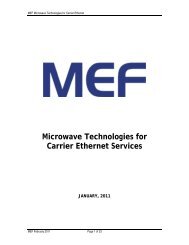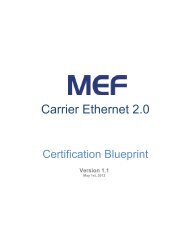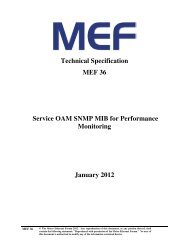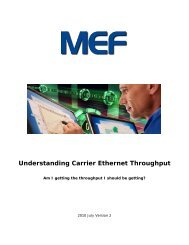Technical Specification MEF 16 Ethernet Local Management Interface
Technical Specification MEF 16 Ethernet Local Management Interface
Technical Specification MEF 16 Ethernet Local Management Interface
Create successful ePaper yourself
Turn your PDF publications into a flip-book with our unique Google optimized e-Paper software.
<strong>Ethernet</strong> <strong>Local</strong> <strong>Management</strong> <strong>Interface</strong> (E-LMI)<br />
The UNI-N MUST respond to a Full Status Continued STATUS ENQUIRY with a Full<br />
Status STATUS or Full Status Continued STATUS message starting at the next EVC<br />
Reference ID that follows the last EVC Status information element reported by the UNI-<br />
N in the previous STATUS message. The Full Status STATUS response MUST be sent<br />
when the UNI-N can fit all remaining EVC Status information elements in the STATUS<br />
message.<br />
4) The UNI-C SHALL parse the STATUS message depending on the Report Type. If it is a<br />
Full Status, or Full Status Continued STATUS message, the UNI-C SHOULD update its<br />
configuration according to the status of the UNI and the status and service attributes of<br />
each configured EVC.<br />
Upon receipt of a Full Status Continued STATUS message, the UNI-C SHALL continue<br />
to request EVC status by sending a Full Status Continued STATUS ENQUIRY message<br />
(without waiting for the Polling Timer to expire). The UNI-C SHALL restart Polling Timer<br />
with value T391 each time it transmits a Full Status Continued STATUS ENQUIRY<br />
message. When the UNI-N responds with a Full Status STATUS message, it is an indication<br />
that all information has been sent.<br />
5) The UNI-C SHALL compare the EVC reference ID sent in the full status with the previously<br />
reported EVC reference ID and omission of any EVC reference ID will result in<br />
deletion of that EVC.<br />
Note that the single EVC asynchronous STATUS message is not part of the periodic polling<br />
process.<br />
5.6.3 Sequence Numbers<br />
The purpose of the Sequence Numbers information element is to allow the UNI-N and the UNI-<br />
C to determine the status of the E-LMI process including correlating STATUS ENQUIRY messages<br />
with STATUS messages.<br />
The UNI-C and the UNI-N maintain the following internal counters:<br />
• The send sequence counter SHALL maintain the value of the send sequence number<br />
field of the last Sequence Numbers information element sent;<br />
• The receive sequence counter SHALL maintain the value of the last received send sequence<br />
number field in the Sequence Numbers information element and SHALL maintain<br />
the value to be placed in the next transmitted received sequence number field.<br />
The following procedure is used:<br />
1. Before any messages are exchanged, the UNI-N and the UNI-C set the send sequence<br />
counter and receive sequence counters to zero.<br />
2. Each time the UNI-C sends a STATUS ENQUIRY message, it SHALL increment the<br />
send sequence counter and place its value into the send sequence number field. It also<br />
SHALL place the current value of the receive sequence counter into the receive sequence<br />
<strong>MEF</strong> <strong>16</strong><br />
© The Metro <strong>Ethernet</strong> Forum 2006. Any reproduction of this document, or any portion thereof, shall contain the<br />
following statement: "Reproduced with permission of the Metro <strong>Ethernet</strong> Forum." No user of this document is<br />
authorized to modify any of the information contained herein.<br />
Page 20








